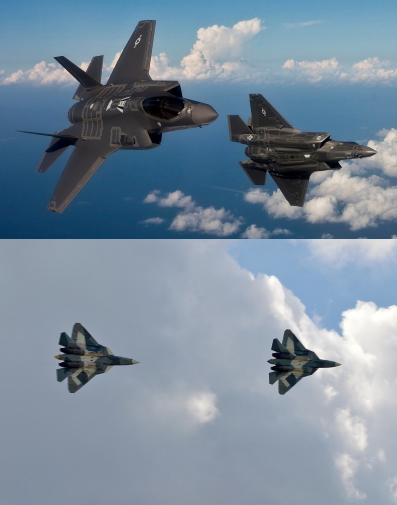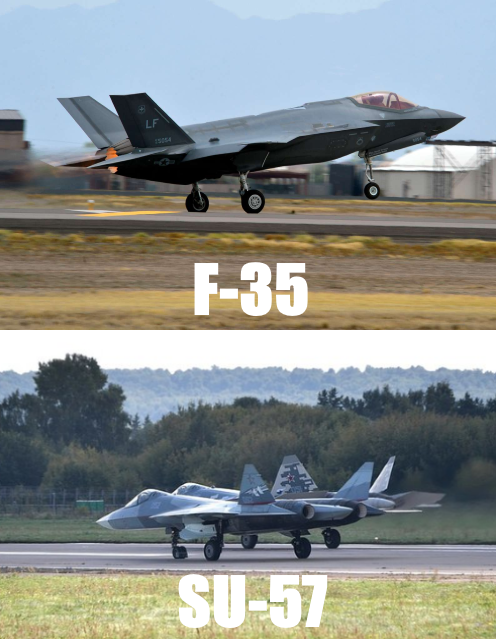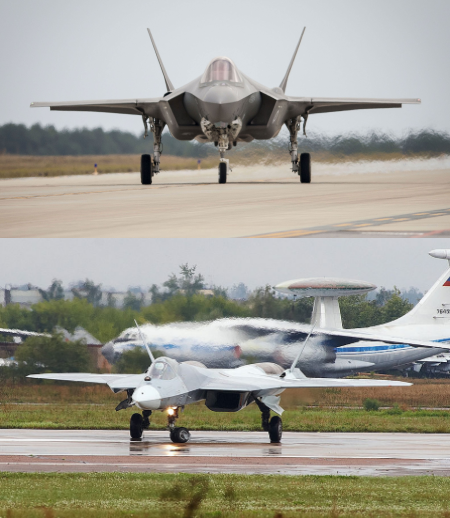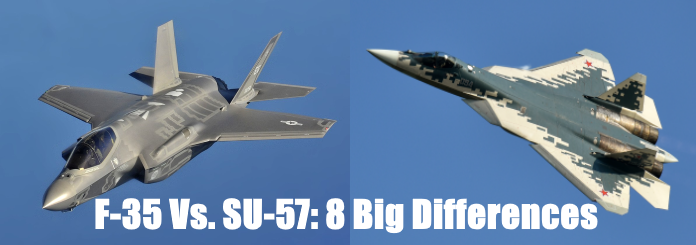The debate between the F-35 vs. Su-57 is a close determination.
On one hand, the Russian Sukhoi Su-57 Felon is extraordinarily fast and lethal.
Meanwhile, the U.S. F-35 Lightning II is one of the most versatile and incredible fighter jets you’ll ever witness.
For this reason, it’s not easy deciding which jet is better – F-35 vs. Su-57.
Therefore, if you want to dive into the discussion, let’s begin by examining 8 noteworthy differences between the F-35 and Su-57.
Related Article – F15 Vs. F22: Top 10 Differences Between The Eagle & Raptor
F-35 vs SU-57: 8 Big Differences

In the new Top Gun movie, Maverick (Tom Cruise) takes to the skies and faces off against a SU-57 fighter jet.
It appears that the filmmakers purposely put the 5th generation aircraft into Top Gun: Maverick for a reason.
After all, there is concern that the SU-57 fighter jet (referenced by NATO as “Felon”) is the latest threat to American supremacy in the skies.
However, as Maverick demonstrates in the sequel, it poses no threat to the F-35C (and other American fighters like the F/A-18 Super Hornet).
Indeed, since its arrival in 2015, the F-35 is largely considered the premiere advanced multi-role strike fighter.
More importantly, the recent arrival of the SU-57 as a direct competitor to the F-35 has not served well for Russia.
The empire has only managed to produce 76 of them to date, and some experts label the SU-57 among the worst of the 5th generation fighters.
Nonetheless, there is still legitimate fear about the SU-57 Felon considering that it’s faster and more advanced than the F-35 in other areas.
Thus, if you want to settle who wins the debate – F-35 vs SU-57 – let’s first begin with 8 big differences:
#1. History
The F-35 has origins in the Joint Strike Fighter (JSF) program.
It was created to serve as a replacement for the F-16 at approximately the same time as the F-22.
In the end, Lockheed Martin developed a single-engine design that was incredibly fast and lightweight for a 5th generation aircraft.
As such, the F-35 first took flight in 2006 yet didn’t officially enter service until 2015.
Be that as it may, the F-35 has still been around far longer than the Su-57.
Currently, there are several variants of the F-35, including:
- F-35A (U.S. Air Force)
- F-35B (Marine Corps)
- F-35C (U.S. Navy)
- F-35l “Adir”
The United States is not the only country that utilizes F-35 fighters.
In fact, several allied nations frequently fly the F-35 including Israel, Australia, Italy, and Norway.
In 1979, the Soviet Union outlined a need for designing a next-generation fighter.
The Su-57 has been troubled by countless delays.
It was initially scheduled to enter service in the 90s yet has been stalled by numerous production problems.
The Sukhoi Su-57 was meant to replace the MiG-29 and Su-27 fighters.
As a result, the Su-57 is considered a 5th generation stealth fighter.
The modern jet is capable of aerial combat as well as ground and maritime combat.
There are a few variants of the Su-57, which has an anticipated service life of only 35 years:
- Su-57
- Su-57E
- Su-57M
Despite featuring an impressive radar range and terrific maneuverability, other stealth problems have haunted the Su-57.
In fact, the modern fighter did not appear in the early days of the Ukraine invasion.
Related Article – F-16 Vs. F-18: Top 10 Differences Between The Viper & Super Hornet
#2. Characteristics
Okay, so the Su-57 lacks the same history as the F-35.
Nevertheless, when you compare specifications, the Su-57 rivals the F-35 stealth fighter in many regards.
For starters, the Su-57 Felon is substantially larger than the F-35.
The dimensions indicate that the Felon fighter is more than 14 feet longer, as well as features a larger wingspan (48 ft 3 in compared to 35 ft).
Both fighters only accommodate 1 pilot, yet the Su-57 weighs significantly more than the F-35.
Of course, there are tradeoffs to supporting a longer, bigger, heavier aircraft.
For example, a larger airframe and wingspan results in a larger target for enemy aircraft.
It also poses challenges for maneuverability even if the Sukhoi Su-57 is surprisingly nimble for its size (more details, below).
Lastly, the Su-57 is superior in terms of fuel capacity (22,700 lbs vs 18,250 lbs).
#3. Design
The F-35 is part of a U.S. family of single-engine, supersonic, stealth, multi-role fighters.
It’s the second 5th generation fighter to enter U.S. service after the F-22 Raptor.
The design of the F-35 differs from other advanced fighters in that it emphasizes avionics and long-range combat.
Currently, the United States Air Force (USAF) utilizes the F-35 as its primary strike fighter.
Meanwhile, the U.S. Navy and Marine Corps also depend on variants of the F-35.
The unique wing-tail configuration provides superior stealth along with many other advanced features.
Furthermore, the relatively short wingspan makes the fighter combat even if the F-35 is considerably heavier than the aircraft it replaced.
The F-35 draws inspiration from the F-22 in terms of structure and components.
However, it lacks the raw performance of the larger, twin-engine fighter.
Be that as it may, the F-35 is formidable with other rivals like the F-16 and F/A-18.
Then, there is the Su-57 Felon, which measures up in terms of design even if production issues have haunted the aircraft.
The Su-57 is the first stealth aircraft for Russian armed forces.
Its design emphasizes super-maneuverability, large internal payload bays, and advanced sensor systems.
The multi-role fighter is also noteworthy for stealth even if many believe the Su-57 cannot compete with the F-35.
There are some similarities between the Sukhoi Su-57 and Lockheed Martin F-22 in terms of structural design.
The powerful performance is a worthy adversary in the air from its ability to evade to engage head-on.
#4. Performance

F-35 vs Su-57?
In regards to performance, it’s hard to argue with the Su-57.
First, the Sukhoi Su-57 Felon is significantly faster in the air.
The Su-57 is capable of reaching speeds of over Mach 2 (at altitude) and Mach 1.3 (in super-cruise).
Meanwhile, the F-35 only reaches max speeds of Mach 1.6 (1,119 mph).
Therefore, the Su-57 has the capability of striking first and then escaping before the F-35 can catch up.
Nevertheless, the abilities of a pilot do play a factor, and there are substantially more hours logged with the F-35.
As such, the Su-57 is certainly faster even if it lacks the stealth profile of the F-35 (more information, below).
For this reason, it’s still capable of keeping pace with the Su-57 even if the F-35 cannot beat the fighter (or the F-22) in a race.
#5. Weapons
The Su-57 and F-35 are both fully capable in terms of armament (built-in weapons).
The F-35 has more options for armament, including optional missiles, cannons, and bombs.
In order to preserve the stealth profile, the design incorporates 2 internal weapons bays each with 4 weapons stations.
For this reason, there are many different options for what military personnel determine to load the bays with in terms of weapons.
The 2 outboard weapons stations support heavier ordnance while the inboard stations support air-to-air missiles.
Moreover, air-to-surface weapons are mounted on the outboard station, including the Joint Direct Attack Munition (JDAM) and Joint Standoff Weapon (JSOW).
The station also supports multiple, smaller munitions (GBU-39 Bombs, SPEAR 3 Anti-Tank Missiles, etc).
The AIM-120 AMRAAM is mounted on the inboard station.
Furthermore, the F-35 profile utilizes 6 external weapons stations for missions that do not require stealth.
The standard armament for the F-35A is a 1 x 25mm GAU-12/U internal 4-barreled automatic cannon.
On the other hand, the F-35B and F-35C variations feature a 1 x 25mm GAU-12/U cannon in an external pod, or “missionized gun.”
Finally, the wings maintain their own armament stations.
The Su-57 does not support nearly the same diverse collection of armament.
Its weapons include a standard 1 x 30mm GSh-30-1 internal cannon and optional air-to-air or air-to-surface missiles.
For air-to-air combat, the Su-57 features 4 beyond-visual-range missiles in the 2 main weapons bays.
The armament is supported by 2 short-range missiles along the side bays.
The primary medium-range missile is the active radar-homing R-77M.
Meanwhile, the short-range missile is the heat-seeking R-74M2.
Furthermore, the Su-57 supports precision-guided bombs along with internal weapons.
Lastly, with missions that do not require stealth, the Felon fighter provides 6 external hardpoints for weapons.
Related Article – F-15 Vs. F-16: Top 10 Differences Between The Fighter Jets
#6. Stealth Capabilities
While both fighters are designed to be stealthy there is no question that the F-35 is more effective.
Stealth, in fact, is the one thing that really distinguishes the aircraft in the F-35 vs Su-57 debate.
For starters, the radar cross-section (RCS) of the F-35 is minimized through careful design of the airframe.
Moreover, the radar-absorbent materials (RAM) and other components of the aircraft make it nearly undetectable.
Accordingly, the RCS of the F-35 is one of the best and rivals other advanced stealth aircraft like the F-22.
The Sukhoi Felon, on the other hand, is Russia’s first attempt at creating its own stealth aircraft.
In the past, the Soviets have rivaled U.S. aircraft in many regards, however, stealth has not been one of them.
Therefore, while the Su-57 does employ some advanced stealth features it has also suffered from poor design, as well.
The Su-57 fighter utilizes several methods to reduce its radar signature.
First, it borrows much of the design from the F-22 to reduce radar cross-section (RCS).
Secondly, radar absorbent material (RAM) combines with the airframe shape to reduce the RCS 30x smaller than that of the profile of the Su-27 aircraft.
Nevertheless, the Su-57 continues to trail behind the F-22 Raptor and F-35 Lightning II in regards to stealth.
Therefore, while the Su-57 may have the size and speed, the F-35 could still target its adversary before it’s ever discovered by the Felon.
The end result would be the F-35 would be first to strike leading to a tactical advantage.
#7. Avionics
The avionics of the F-35 Lightning II are also extraordinary.
It’s another aspect that separates which fighter is more elite in the F-35 vs Su-57 discussion.
For starters, the F-35 mission systems are considered among the most complex of any aircraft.
The avionics and sensor fusion are designed to enhance the situational awareness of a pilot.
Accordingly, it presents U.S. pilots with yet another tactical advantage in the sky.
Furthermore, the F-35 supports command and control capabilities along with network-centric warfare.
Among the noteworthy sensors in the F-35:
- Northrop Grumman An/APG-81 AESA Radar
- BAE Systems AN/ASQ-239 Warfare System
- Northrop Grumman DAS System
- Lockheed Martin EOTS Targeting System
- Northrop Grumman Communications CNI Suite
The F-35 Lightning II is equipped with technology that presents a cohesive image of nearby battlespace.
Moreover, the stealth jet transitions into an electronic warfare system.
Thus, the F-35 can detect and jam hostile radars as well as track approaching targets.
Then, there is the Su-57 fighter to consider, which puts up a solid fight.
Despite some delays, the Su-57 has sought to improve avionics to increase the pilot’s situational awareness, like the F-35.
Additionally, the avionics of the Su-57 are designed to reduce pilot workload.
For this reason, the features could one day serve as a test pilot for advanced AI and man-unmanned operations in the sky.
It’s one of the many aspiring goals of future, 6th generation fighters.
For now, the Su-57 offers some impressive avionics of its own including the ability to fly autonomously without pilot input.
The onboard systems on the Su-57 are controlled by the Information Management System (IUS).
Meanwhile, the main avionics systems are the MIRES and 101KS Atoll system.
The Su-57 is the first fighter to mount a DIRCM system and deploys other countermeasures (flares, radar decoys, ECM transmitters).
#8. Reputation
Finally, there is the reputation of each aircraft to consider.
The F-35 offers more history and tradition.
Its accomplishments in the air are much more impressive and noteworthy.
For starters, the Su-57 has barely entered the sky let alone achieved much in terms of operations.
The F-35A and F-35B were both cleared for basic flight training in 2012.
They each entered service 5-6 years later after working out some of the initial concerns.
Since then, the F-35 fighter has garnered a tremendous reputation in the Air Force, Navy, and Marine Corps.
Currently, all 3 military branches continue to use some variant of the F-35.
The U.S. Air Force designates the F-35A as its primary striker.
Accordingly, they were first deployed in 2019 and carried out airstrikes in Iraq.
Furthermore, F-35 stealth fighters have been utilized by several other nations, including Israeli operations.
The same is not true of the Sukhoi Su-57 Felon, which lacks the same credibility.
For starters, it’s only been around a short period of time after arriving in 2020.
Then, one must also consider its shaky beginning.
The Su-57 has been dogged by development delays as well as disappointing trials.
It has been announced that the first fully operational Su-57 regiment of 24 aircraft will arrive in 2025.
In October 2022, it was confirmed that Su-57 fighters were involved in the invasion of Ukraine.
For now, the Su-57 lacks the same reputation as the F-35 as well as other elite U.S. aircraft.
F-35 vs SU-57 – Which Aircraft Is Superior?

Who wins the aerial showdown: F-35 vs Su-57?
It’s a debate that revolves around 2 modern fighter jets:
- Lockheed Martin F-35 Lightning II
- Sukhoi Su-57 Felon
The Su-57 is a brand new, 5th generation fighter.
Meanwhile, the reputation of the F-35 is unparalleled for a modern stealth fighter.
F-35 Lightning II
The Lockheed Martin F-35 is widely considered one of the best stealth fighters.
It’s often compared to other elite fighter jets such as F-22 Raptor.
The single-seat, single-engine 5th generation multi-role aircraft performs air superiority and strike missions.
Meanwhile, its advanced avionics (more details, below) provide means for electronic warfare and intelligence, surveillance, and reconnaissance capabilities.
What’s more, there are no plans to shelf the F-35 fighter jet anytime soon with plans to continue production through 2044.
Impressively, the F-35 also factors to represent the cornerstone of NATO and U.S.-allied air force units until 2070.
Su-57 Felon
The Sukhoi Su-57 Felon, meanwhile, anticipates competing with the F-35 in the near future.
Currently, there is a very limited number in service.
However, the twin-engine stealth multi-role fighter does feature some impressive characteristics.
It’s the first aircraft in Russian military service with stealth technology.
On the other hand, the Su-57 has been plagued by issues in production, including the first that rolled off assembly, which crashed during its initial flight.
Furthermore, the advanced Su-57 only recently appeared in the Ukraine war.
Even worse, India backed out of purchasing the Su-57 over concerns that its stealth capabilities were not worth the high price tag.
In the end, it may simply come down to numbers.
There are far more F-35s in service than anticipated Su-57s.
Even more noteworthy, Russian pilots lack experience operating the Felon compared to U.S. experience with the F-35 variants.
Related Article – Navy Pilot Vs. Air Force Pilot
Conclusion
There is little debate — the Lightning II wins the battle between the F-35 vs Su-57.
The F-35 features superior stealth and avionics.
Yes, the Su-57 Felon is bigger and faster, but that also makes it a larger target for the more stealthy Lightning II.
Then, there is the quality of pilots along with the number of Su-57s currently in production compared to F-35 stealth fighters.
In the end, it’s hard to catch a fighter you cannot detect and first catch off guard.
Sure, the Su-57 may feature some impressive capabilities, but that does little against the best stealth fighter on earth.
As a result, if you are predicting who would win in direct combat, it’s hard to argue with the F-35 fighter.
Featured Images:
F-35 Profile – www.Wikipedia.org
Su-57 Profile – www.Wikipedia.org
- Replacing Dog Tags: 6 Things You Need to Know - June 28, 2024
- Navy OAR Test Study Guide - June 24, 2024
- 10 Best Sniper Movies of all Time - June 20, 2024
Originally posted on December 2, 2022 @ 10:13 pm
Affiliate Disclosure: This post may contain affiliate links. If you click and purchase, I may receive a small commission at no extra cost to you. I only recommend products I have personally vetted. Learn more.

